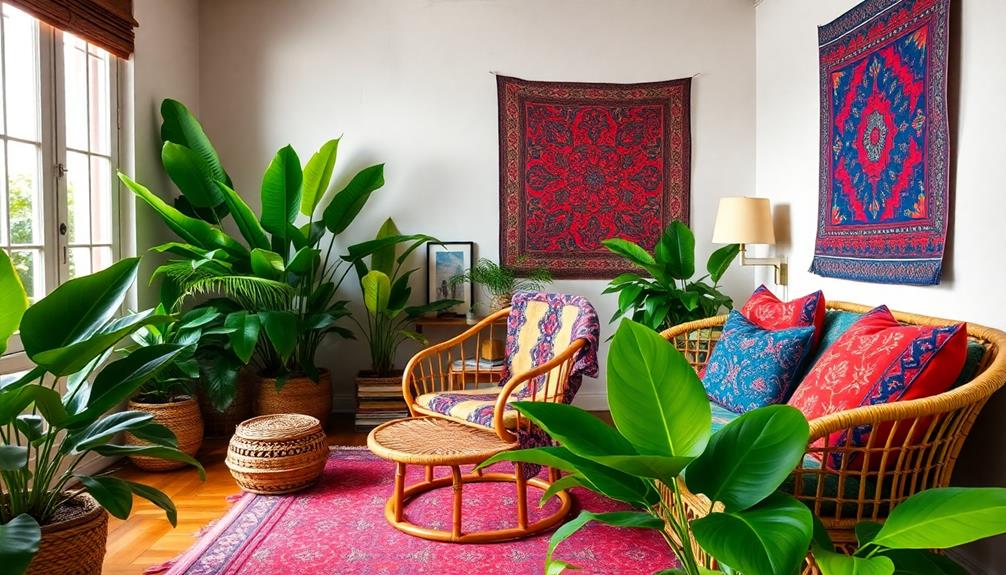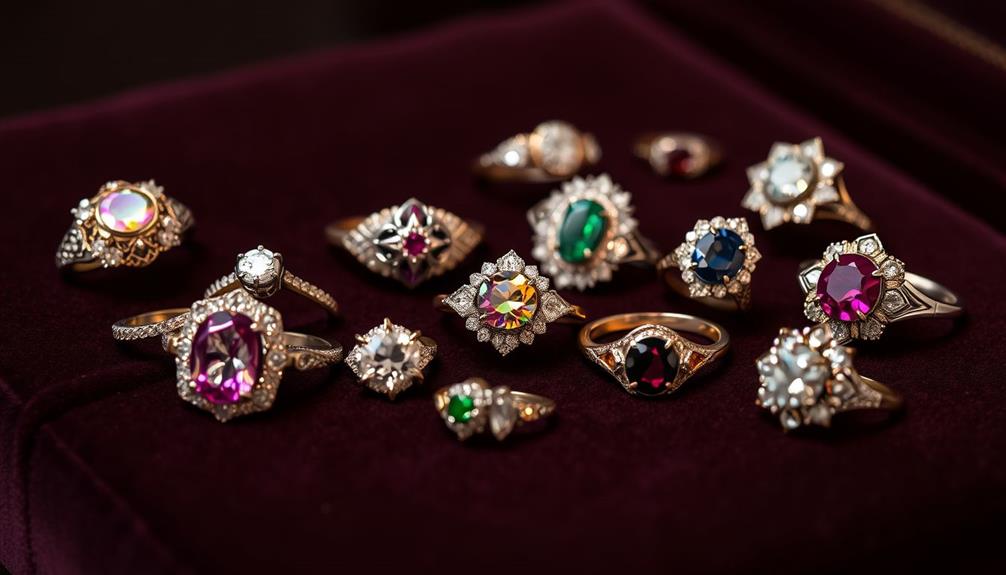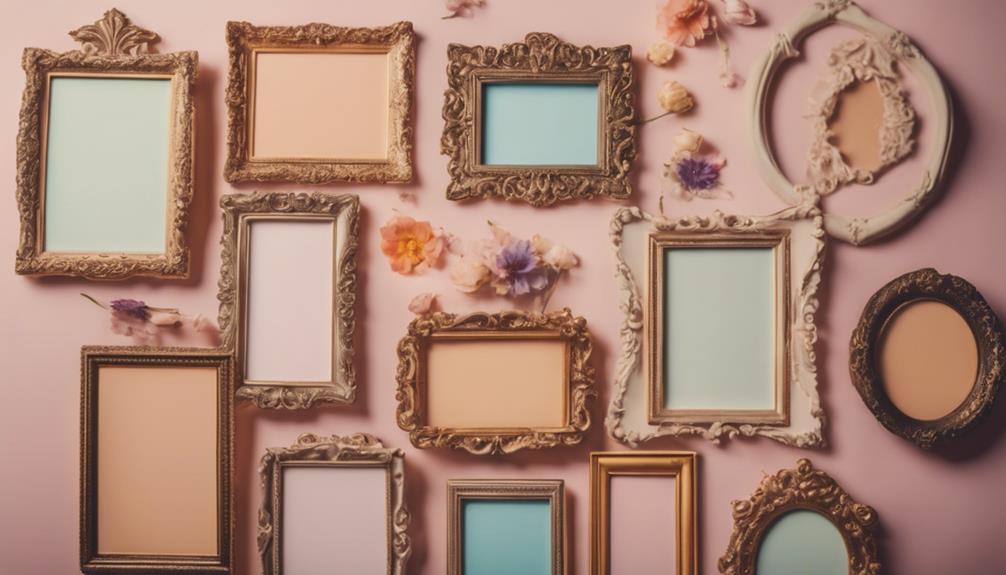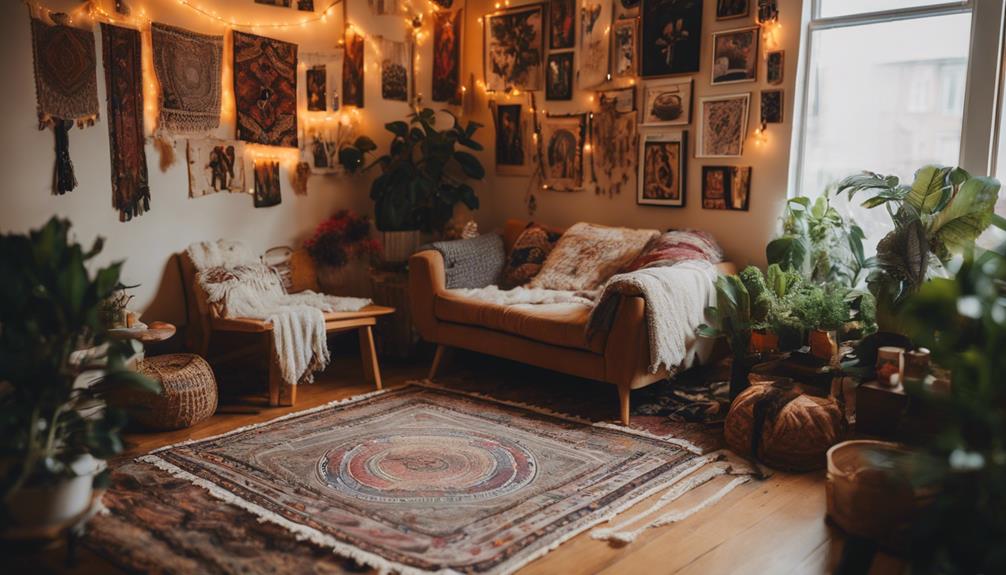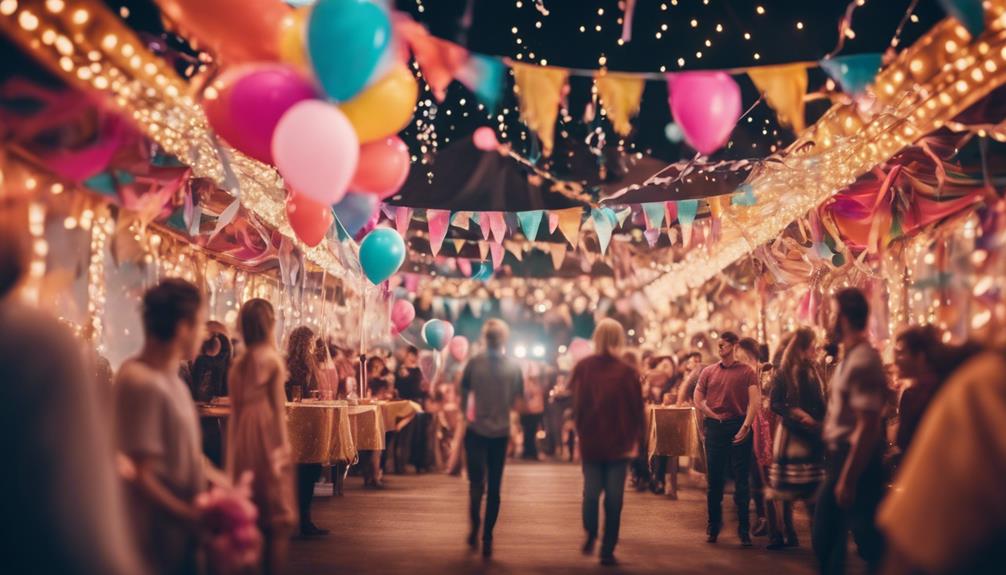Indonesian textiles can instantly transform your space, infusing it with vibrant colors and intricate patterns. Using pieces like Batik or Ikat as accent pillows or wall hangings adds warmth and character. These fabrics carry rich cultural stories and meanings, making each item a statement piece in your decor. You'll find that mixing textures, like pairing Batik with moire, creates a visually dynamic atmosphere. Plus, incorporating sustainable textiles not only beautifies your home but also supports eco-friendly practices. You'll want to explore more ways to incorporate these stunning textiles into your space for an even greater impact.
Key Takeaways
- Incorporate vibrant Indonesian textiles, like Batik or Ikat, to instantly add warmth and character to your living space.
- Use statement pieces such as accent pillows or layered bedding to create focal points that reflect cultural artistry.
- Mix and match patterns and textures, combining moire with Ikat and Batik for a rich visual tapestry in your decor.
- Embrace natural dyes and eco-friendly fabrics to enhance your space sustainably while celebrating traditional craftsmanship.
- Visit local markets or cultural festivals to find authentic Indonesian textiles that bring unique stories and heritage into your home.
The Rich History of Indonesian Textiles

As you explore the rich history of Indonesian textiles, you'll discover that each piece tells a story woven into the fabric of the nation's diverse cultures. From Batik to Ikat and Songket, these textiles reflect the artistic expressions of various ethnic groups across the archipelago, much like the intricately designed Indonesian Decor Masks that celebrate cultural heritage.
Batik, recognized by UNESCO as an Intangible Cultural Heritage, uses intricate wax-resist dyeing techniques that have been practiced for centuries. Each pattern often carries deep meanings and narratives unique to its origin.
Ikat weaving stands out for its unique blurred designs, resulting from the meticulous process of tying and dyeing yarns before weaving. This method showcases the skill and artistry that artisans have honed through generations.
Songket, a luxurious handwoven fabric adorned with gold or silver threads, emphasizes Indonesia's historical trade connections and royal influences. Often worn during ceremonial occasions, it represents both cultural heritage and social status.
The textile industry doesn't just preserve these traditions; it greatly contributes to Indonesia's economy, generating billions in exports while promoting sustainability and craftsmanship within local communities.
Understanding this rich history is essential as you embrace the beauty and significance of Indonesian textiles in your space.
Key Characteristics of Indonesian Fabrics
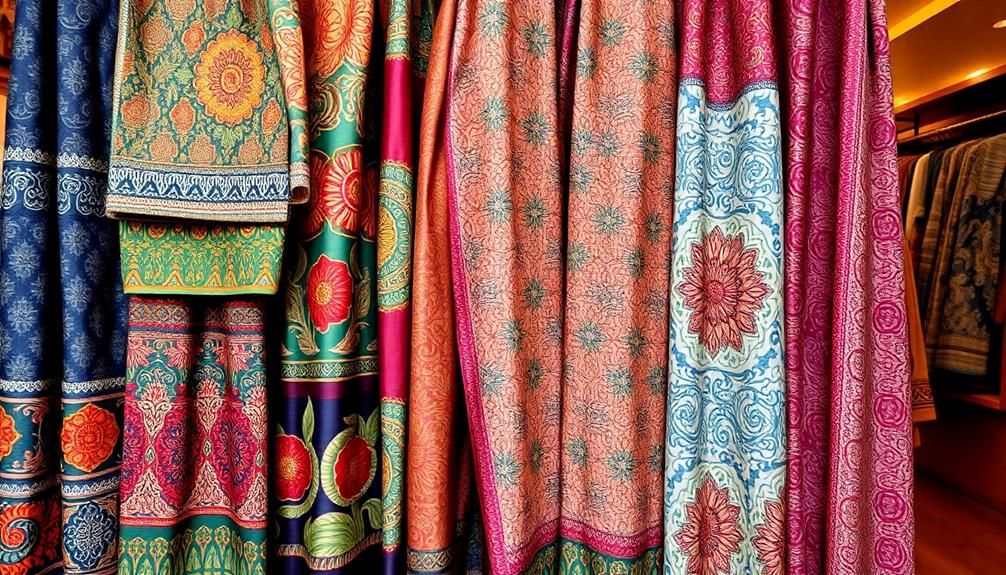
When you explore Indonesian fabrics, you'll notice their vibrant color palettes that instantly catch your eye.
These textiles often incorporate motifs and designs inspired by traditional artistry found in masks, adding layers of cultural depth to their appeal.
The intricate patterns tell stories rich in cultural symbolism and heritage, reflecting the artistry of the region.
Each piece not only serves as a fashion statement but also as a celebration of Indonesia's diverse traditions.
Vibrant Color Palettes
Drawing inspiration from Indonesia's rich cultural heritage and lush landscapes, its textiles are celebrated for their vibrant color palettes.
These bold hues, including rich reds, deep blues, and earthy tones, not only reflect the country's diverse culture but also enhance your space's aesthetic. The traditional dyeing techniques, such as batik and ikat, use natural dyes that create unique color variations and intricate patterns, each telling a story of heritage and craftsmanship.
Incorporating Indonesian Decorative Pillows into your decor can further elevate the visual appeal and comfort of your living spaces.
Here are four key aspects of these vibrant color palettes:
- Contrasting Colors: The use of contrasting shades creates striking visual effects, perfect for statement pieces.
- Metallic Accents: Many fabrics incorporate metallic threads, adding depth and a luxurious touch to your decor.
- Dynamic Transformations: Bold colors can effortlessly transform any space, making them suitable for both contemporary and traditional styles.
- Cultural Representation: Each color and pattern resonates with Indonesia's cultural narratives, bringing a sense of history into your home.
Intricate Pattern Designs
Intricate pattern designs define Indonesian fabrics, showcasing a rich tapestry of cultural storytelling. You'll find that these fabrics often feature stunning techniques like Batik and Ikat, which have origins steeped in tradition.
Batik employs a wax-resist dyeing method that allows for detailed motifs, each piece telling its own unique story. From natural elements to geometric shapes, the intricate patterns invite you to explore their depths. Additionally, these textiles often reflect the cultural heritage and traditions of Indonesia, making them not just decorative but also meaningful pieces of art that can enhance your home decor.
Indonesian decor masks also embody this storytelling aspect through their intricate designs.
On the other hand, Ikat textiles present blurred patterns that are achieved by dyeing the yarns before weaving. This technique results in visually striking designs that add a dynamic flair to any space. The vibrant colors, derived from natural dyes, not only enhance the fabrics' aesthetic appeal but also promote sustainable practices in the textile industry.
You can incorporate these intricate patterns into various decor elements, such as upholstery, curtains, and accent pillows. By doing so, you'll instantly transform your space, infusing it with an artistic touch that reflects the beauty of Indonesian craftsmanship.
Cultural Symbolism and Heritage
Indonesian fabrics aren't just visually stunning; they're steeped in rich cultural symbolism and heritage. Each piece tells a story, connecting you to the traditions and beliefs of the Indonesian people.
By incorporating these textiles into your space, you embrace a deeper understanding of their significance. For instance, Indonesian Wedding Decor Ideas often feature these intricate textiles, showcasing their beauty and cultural relevance.
Here are four key characteristics of Indonesian fabrics that highlight their cultural symbolism:
- Batik's Intricate Patterns: Recognized by UNESCO, Batik employs a wax-resist dyeing technique, showcasing regional motifs that reflect local histories and identities.
- Ikat's Unique Technique: The blurred patterns of Ikat represent community identity, often used in ceremonial garments, emphasizing their role in significant life events.
- Natural Dyes: Derived from local plants and minerals, natural dyes not only enhance sustainability but also connect the textiles to Indonesia's rich biodiversity.
- Social Significance: Certain designs are reserved for specific life events, like weddings or funerals, reinforcing communal values and cultural heritage.
Popular Types of Indonesian Textiles
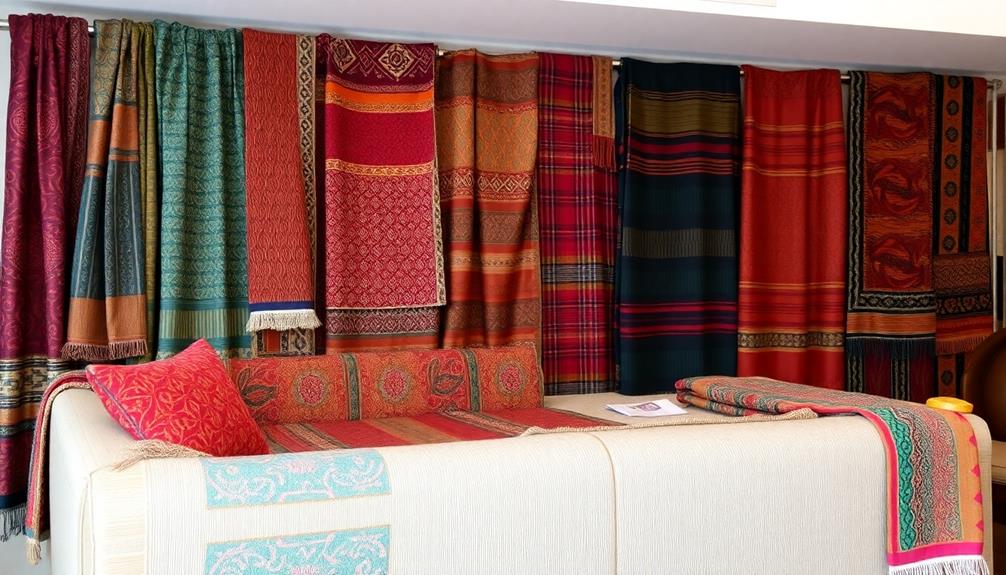
In the vibrant world of textiles, you'll discover a rich tapestry of popular styles from Indonesia that showcase the country's diverse cultural heritage. One of the most recognized is Batik, a traditional textile distinguished by its intricate, colorful patterns created using a wax-resist dyeing technique. Batik often features natural motifs and cultural symbols, making it a timeless choice.
Another fascinating style is Ikat, where threads are dyed before weaving, resulting in vibrant, blurred patterns. This modern twist on a traditional craft varies by region, adding unique character to each piece.
Songket, a luxurious fabric made from silk or cotton, incorporates gold or silver threads, often used in ceremonial attire, reflecting Indonesia's rich heritage.
For everyday use, Tenun showcases a variety of regional techniques with geometric patterns and bright colors, making it perfect for modern home decor.
Ultimately, Kain panjang serves multiple purposes, from sarongs to decorative wall hangings, embodying versatility in daily life.
Whether you choose traditional or modern styles, Indonesian textiles will enhance your space beautifully, adding depth and cultural significance. Indonesian textiles, such as batik and ikat, can be used in a variety of ways – as throw pillows, wall hangings, or even as upholstery fabric. One Indonesian textile trick is to mix and match different patterns and colors to create a visually dynamic and interesting space. Additionally, incorporating Indonesian textiles into your home decor can also serve as a conversation starter, allowing you to share the rich history and traditions behind each piece with your guests.
Transforming Spaces With Textiles
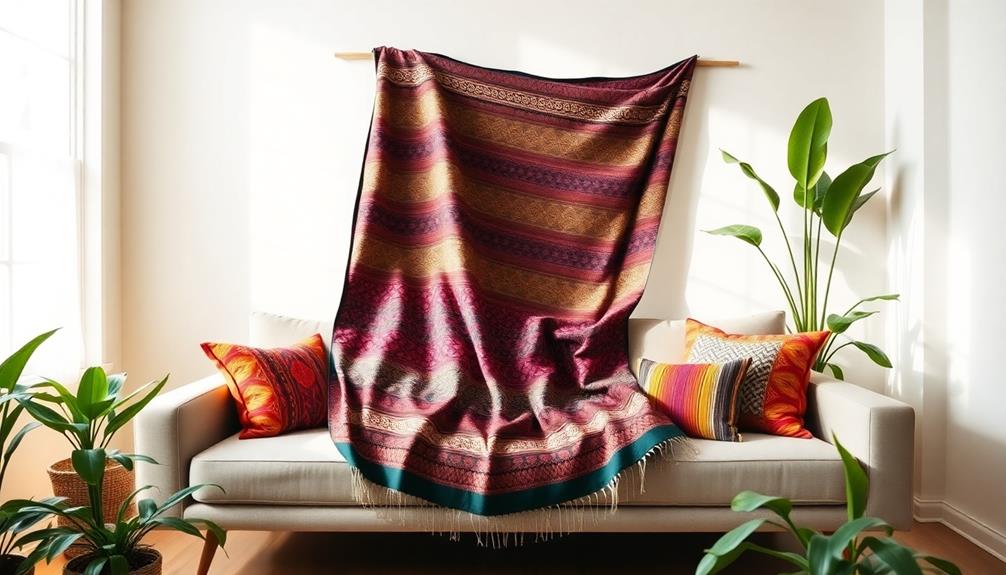
Textiles offer a powerful way to transform your living spaces, bringing warmth and character that can redefine any room. By tapping into the vibrant textile market, you can choose unique pieces that reflect your personal style while enhancing your home's aesthetic.
Here are four impactful ways to incorporate textiles:
- Moire Curtains: These elegant curtains add texture and sophistication, making a simple room feel more refined.
- Accent Pillows: Use various patterns and textures to create a cozy atmosphere without overwhelming your decor.
- Vintage Lighting: Combine textiles with artisan-made pieces to showcase local craftsmanship and create a unique ambiance.
- Layered Bedding: Incorporating throws and rich fabrics makes your space inviting and comfortable, giving it a lived-in feel.
Additionally, consider moire wallpaper for striking statement walls that become focal points in your room.
Choosing sustainable fabrics not only elevates your decor but also aligns with current trends towards environmental responsibility.
Easy Ways to Incorporate Textiles
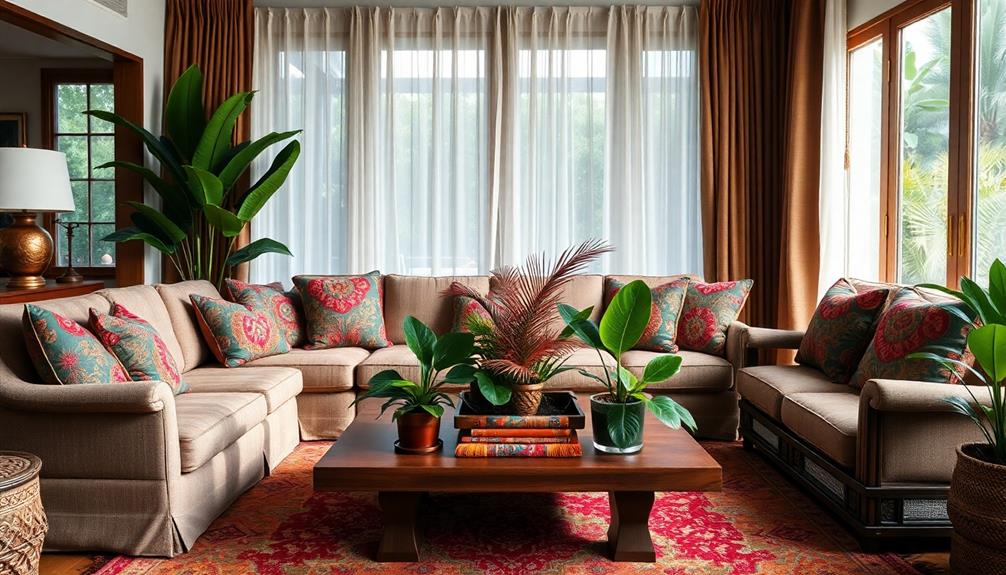
Incorporating textiles into your home can instantly upgrade your space and reflect your personal style. One of the easiest ways to do this is by adding moire curtains. They elevate the aesthetic of any room, enhancing light reflection and creating a luxurious ambiance.
You can also introduce moire accent pillows or throws to add subtle texture and visual interest without overwhelming your existing decor. These pieces are perfect for layering with other fabrics.
Consider using moire wallpaper on a statement wall to create a striking focal point, showcasing the unique swirling patterns that moire textiles are known for.
If you want to transform your bedroom into a sophisticated retreat, opt for moire bedding. It combines timeless style with comfort, making your space inviting.
Color and Pattern Inspiration
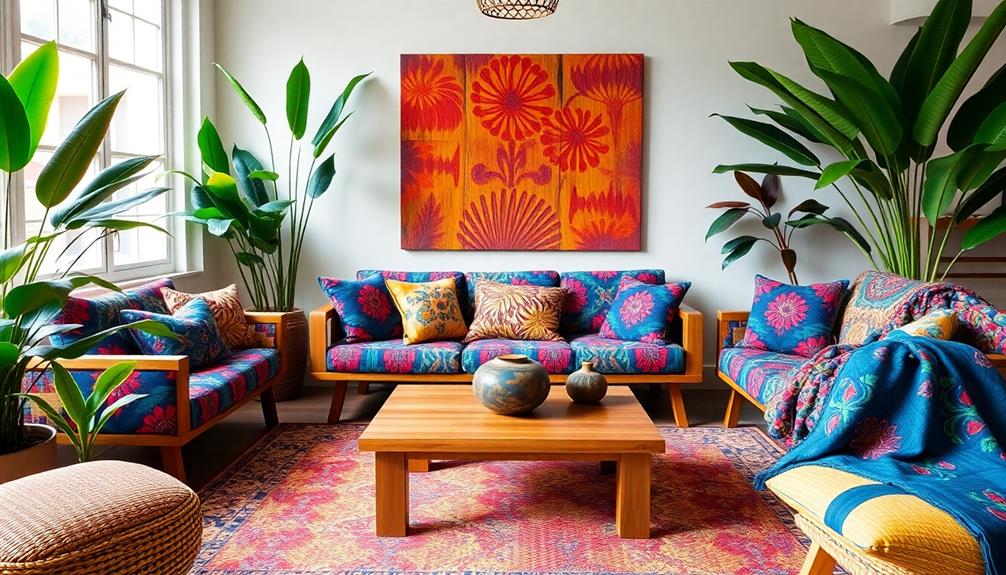
When you think about Indonesian textiles, vibrant color palettes immediately come to mind, offering a burst of energy to your decor.
Layered pattern mixing can transform your space, allowing you to showcase the intricate cultural motifs that tell unique stories.
Embracing these elements not only enhances visual appeal but also invites a deeper connection to the rich heritage behind each piece.
Vibrant Color Palettes
Throughout history, Indonesian textiles have captivated designers and homeowners alike with their vibrant color palettes. These textiles boast rich hues like deep reds, vibrant yellows, and lush greens, reflecting Indonesia's diverse natural landscapes and rich cultural heritage.
When you incorporate these bold colors into your home decor, you'll not only enliven your space but also create striking focal points that draw the eye.
Here are four ways to embrace vibrant color palettes in your home:
- Accent Pillows: Use textiles with contrasting colors to add dynamic visual interest.
- Wall Hangings: A large piece can serve as a stunning statement in any room.
- Table Runners: Brighten up dining areas with colorful patterns that evoke warmth.
- Throws and Blankets: Add layers of texture and color for a cozy, inviting atmosphere.
Integrating these textiles will evoke a sense of warmth and liveliness, stimulating creativity and energy.
Plus, the growing trend of Indonesian textiles in modern interior design means you'll be ahead of the curve while creating an eclectic yet cohesive aesthetic in your space.
Layered Pattern Mixing
Building on the vibrant color palettes of Indonesian textiles, layered pattern mixing takes your decor to the next level by weaving together various designs and textures. This approach allows you to combine different textiles, like moire fabric with ikat and batik prints, creating a rich visual tapestry that showcases both cultural heritage and contemporary design elements.
When you utilize a variety of textures alongside patterns, such as pairing soft moire curtains with bold batik accent pillows, you add depth and sophistication to your space without overwhelming the senses.
For color inspiration, look to nature—incorporating earthy tones and vibrant hues found in Indonesian textiles can create a harmonious yet dynamic aesthetic.
While mixing patterns, consider the scale of designs; larger patterns can serve as focal points while smaller prints complement them without competing. This balance is key to achieving an elegant look.
Cultural Motif Integration
Incorporating cultural motifs into your decor can breathe new life into your space, transforming it into a vibrant reflection of Indonesian artistry. The unique blend of rich colors and intricate patterns found in Indonesian textiles, like Batik, Ikat, and Songket, can easily elevate your home.
Here are four ways to embrace cultural motif integration:
- Color Palette: Use warm browns and vibrant reds inspired by traditional dyes to create an energizing atmosphere.
- Focal Points: Choose textiles with complex patterns as statement pieces, drawing the eye and adding depth to your design.
- Mono-Room Harmony: In contemporary mono-rooms, let the intricate designs of Indonesian textiles shine without competing colors, maintaining a cohesive look.
- Support Local Artisans: By selecting artisan-made textiles, you not only enrich your decor but also contribute to local economies, enhancing authenticity and sustainability.
Embracing these elements won't only beautify your space but also infuse it with the rich cultural significance and craftsmanship that Indonesian textiles represent.
Get ready to transform your home into a stunning showcase of artistry!
Caring for Your Textiles
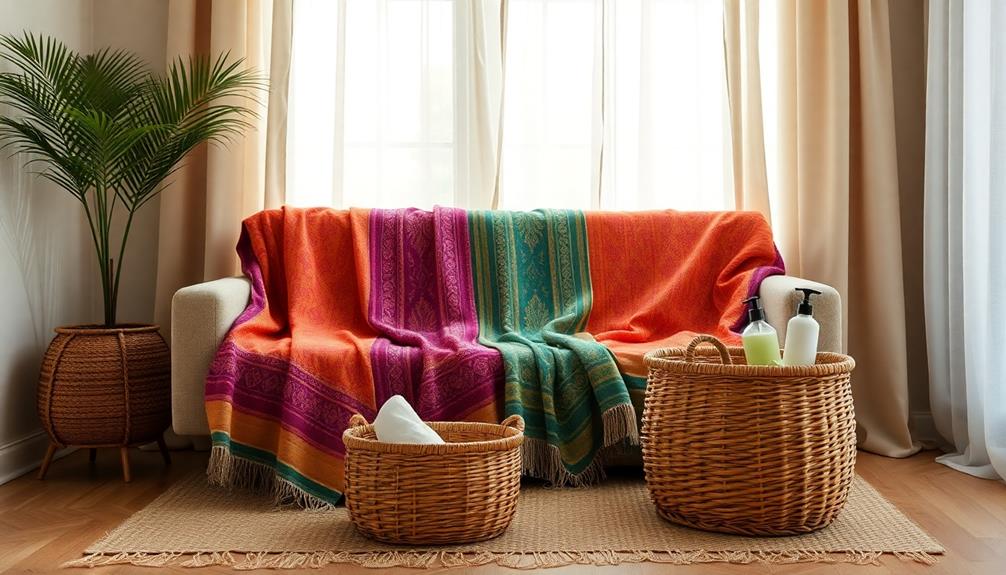
Caring for your textiles is essential to keep them looking vibrant and lasting longer. To maintain the beauty of your sustainable materials, follow these simple steps:
| Task | Tips |
|---|---|
| Dust and Vacuum | Use a soft brush attachment to prevent dirt and allergens from building up. |
| Wash Delicate Fabrics | For Batik or Ikat, always hand wash or dry clean to preserve intricate designs. |
| Store Properly | Keep textiles in a climate-controlled space, away from direct sunlight, to avoid fading. |
Additionally, using fabric protectors and sprays can shield your textiles from stains and spills, ensuring they stay in pristine condition. Regularly inspect your textiles for wear or damage; addressing any issues promptly will help prolong their lifespan.
Sustainable Textile Practices
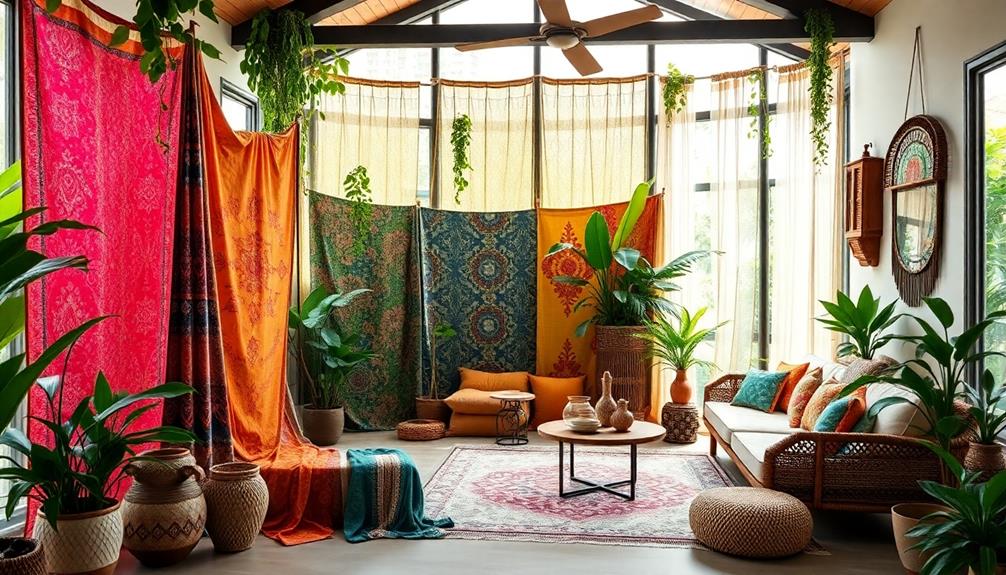
Maintaining your textiles not only enhances their appearance but also lays the groundwork for embracing sustainable practices.
In Indonesia, sustainable textile practices are gaining momentum, focusing on eco-friendly materials and traditional techniques like Batik and Ikat. These methods not only honor cultural heritage but also promote environmental responsibility.
Here are four key aspects of sustainable textile practices in Indonesia:
- Organic Dyes: Shifting to organic dyes reduces harmful chemical use, minimizing water pollution in garment production.
- Natural Fibers: Utilizing natural fibers supports environmentally friendly sourcing and reduces reliance on synthetic materials.
- Advanced Technologies: Many manufacturers are investing in technologies like digital printing to reduce waste and enhance production efficiency.
- Transparency in Supply Chains: Consumer demand for ethically produced textiles encourages producers to adopt transparent practices, ensuring sustainability from sourcing to production.
Cultural Significance of Textiles
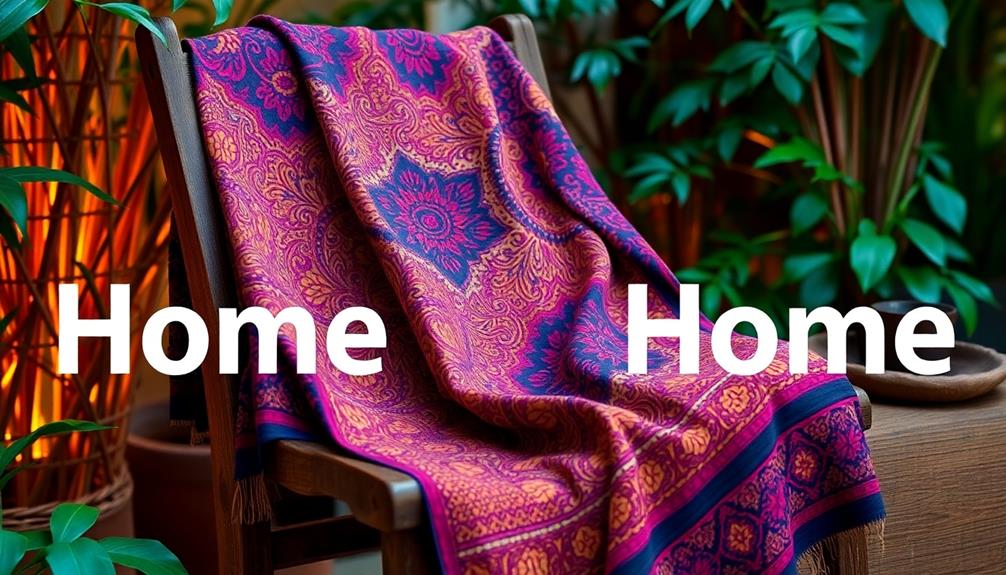
Textiles in Indonesia aren't just fabric; they tell stories of history and identity.
You'll notice how traditional techniques vary by region, each showcasing unique symbolism in their designs.
Historical Textile Practices
In Indonesia, the rich tapestry of historical textile practices reveals a profound cultural significance that transcends mere aesthetics.
These textiles, including Batik, Ikat, and Songket, embody the history, social structures, and artistic expressions of various Indonesian communities.
- Batik: Recognized as a UNESCO Intangible Cultural Heritage, this technique employs a wax-resist dyeing method that dates back to the 6th century, showcasing its enduring importance in Indonesian culture.
- Ikat: This involves dyeing yarns before weaving, a tradition passed down through generations, symbolizing community ties and the preservation of heritage.
- Songket: A luxurious fabric woven with gold or silver threads, Songket is often reserved for ceremonial attire, symbolizing wealth and prestige among Indonesians.
- Modernization: The revival of these historical textile practices in contemporary design not only honors their significance but also boosts Indonesia's profile in the global fashion scene.
Symbolism in Textile Designs
While exploring Indonesian textiles, you'll quickly discover that their designs carry profound cultural symbolism. Each pattern and color often represents specific meanings, like the vibrant red in Batik, which signifies bravery and strength.
These textiles serve as a historical record, conveying stories of ancestry, social status, and rituals through intricate designs and motifs. The use of natural dyes in traditional practices reflects the local environment and cultural beliefs, showcasing vibrant hues derived from indigenous plants and minerals.
You'll notice how textiles can act as a medium for social commentary, with contemporary artists employing traditional techniques to address modern issues, bridging the gap between heritage and current societal challenges.
In Indonesia, weaving textiles like Ikat transcends mere craft; it's a spiritual practice. The act of creation is often accompanied by rituals that honor ancestors and cultural heritage, reinforcing the rich tapestry of meaning embedded in each piece.
Regional Craftsmanship Techniques
Indonesia's rich textile heritage showcases a variety of regional craftsmanship techniques that reflect the nation's diverse cultural identity.
These techniques not only preserve tradition but also inspire contemporary design within the textile sector.
Here are four key craftsmanship methods that embody Indonesia's textile artistry:
- Batik: This wax-resist dyeing technique is recognized by UNESCO as an Intangible Cultural Heritage, emphasizing its importance in Indonesian identity.
- Ikat: A unique process where threads are tied and dyed before weaving, creating complex patterns that represent different ethnic groups' artistic expressions.
- Songket: This luxurious hand-woven fabric features gold or silver threads, traditionally worn during ceremonies to symbolize wealth and status.
- Tenun: A weaving technique that varies across regions, showcasing distinct patterns and colors that tell stories of local culture.
Where to Find Authentic Textiles

Discovering authentic Indonesian textiles is an exciting journey that leads you to vibrant local markets and artisan shops, particularly in regions like Yogyakarta and Bali. These areas are renowned for their rich textile heritage, showcasing stunning pieces like Batik and Ikat that capture the essence of Indonesian culture.
If you can't travel to Indonesia, don't worry! Online platforms like Etsy and specialized textile retailers offer a curated selection of handmade authentic Indonesian textiles, making it easy for you to find unique pieces from the comfort of your home.
Keep an eye out for cultural festivals and textile fairs in Indonesia. These events not only showcase traditional weaving techniques but also provide an opportunity to purchase directly from skilled artisans, supporting local craftsmanship.
The Indonesian government actively promotes the export of traditional textiles, so you may find designated trade shows and exhibitions that feature authentic pieces for international buyers.
Additionally, collaborations between local artisans and global designers often result in exclusive collections available through select boutique retailers and online stores, giving you even more options to enhance your space with authentic Indonesian textiles.
Frequently Asked Questions
What Is the Indonesian Textile Technique?
Indonesian textile techniques include Batik, where you apply wax before dyeing, Ikat, which involves dyeing threads pre-weaving, and Songket, a luxurious fabric woven with metallic threads. Each technique reflects rich cultural heritage and artistry.
What Is the Outlook for the Textile Industry in Indonesia in 2024?
The outlook for Indonesia's textile industry in 2024 looks promising. You'll see growth driven by innovation and sustainability, as the sector aims to enhance production efficiency and meet global demands, boosting employment and trade substantially.
How Big Is the Textile Industry in Indonesia?
You'll find Indonesia's textile industry valued at approximately USD 13.83 billion in 2024. With nearly 2 million people employed, it plays a crucial role in the economy and showcases the country's rich cultural heritage.
Conclusion
Incorporating Indonesian textiles into your space is like adding a splash of color to a black-and-white photo; it transforms everything. By embracing these vibrant fabrics, you not only enhance your environment but also connect with a rich cultural heritage. Remember, "home is where the heart is," and weaving these unique pieces into your decor can create a warm, inviting atmosphere. So, explore, experiment, and let the beauty of Indonesian textiles breathe new life into your home.
